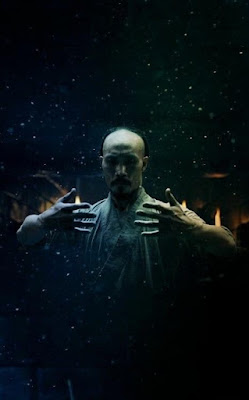
At Ellis Amdur's Kogen Budo blog, there is a guest post by Spyridon Katsigiannis about what he teaches; what he refers to as The Russian Martial Art. An excerpt is below. The full post may be read here.
---
After the release of my book, Hidden In Plain Sight, I began corresponding with Spyridon Katsigiannis (Spyros). He was then living in Sweden, teaching physical culture. He later returned to Greece, and we began to meet regularly, during my biasnnual trips there. He taught me some kettlebell technique, and we informally began an exchange in our various training methodologies to develop greater abilities to use the body in martial arts practice. We were becoming close friends, something I find increasingly rare as I get older, and it was a personal loss to me, as well as his many students, when he suddenly died of a heart attack. The only blessing is that, at the moment of his death, he was with one of his closest students, whom he had brought up, so to speak, into manhood. He did not die alone.
Spyros’s martial arts training started with Chinese martial arts. If I recall correctly, he trained in Hung Gar kung fu, did tournament fighting, and then became a coach. He lost interest in fighting and martial arts, per se, in his early thirties, but became very interested in Russian Martial Arts, interested in it more for physical culture.
In going through some old correspondence, I found some emails containing Spyros’ thoughts on the Russian Martial Art (his term). I’ve done my best to compile them here. I wish he was still alive – a thoughtful man, a strong man. Even in this brief excerpt, one can see that he was researching modern training methodologies, trying to integrate them in his own personal training and those of his physical culture students. Unfortunately, this is all the correspondence I have – conversations with him were so information-rich.
Spyros on using kettlebell training to increase punching power.
Spyros working principle within Systema
Five years ago I took up Russian Martial Art (RMA: both Ryabko-Vasiliev Systema and Alexander Retuinskih‘s
Systema ROSS) because I found that a universal language of hand-to-hand
combat was not only present there, but also articulated in detail. To
my understanding, RMA is a meta-system of distilled scientific martial
knowledge, which is divided in two main bodies: one is comprised of the
bio-mechanical and neurophysiological principles that allow one to
manipulate one’s opponent, by gaining relative superiority through a
mechanically advantageous position. I believe this is akin to today’s
mainstream martial arts, from jūdō and Brazilian jiujitsu to aikidō. The
second body of knowledge is comprised by a great number of solo
training methods designed towards the goal of using the body most
efficiently and generating great amount of power.
These solo training methods include:
- A series of range-of-motion exercises for all joints of the body. The goal of these is increased range of motion (which translates to greater power generation from a purely mechanical perspective), increased coordination and sophistication of movement, plus utilization of the arthrokinetic reflex (discovered in 1956, it was found that something done to a joint can reflexively cause muscle activation or inhibition).
- A series of “wave” movement patterns for the whole body that teach successive joint recruitment, which results in greater power generation through the utilization of stored elastic energy in the connective tissues of the body.
- A series of “floorwork” exercises (various rolls and crawling movements), which although useful when one wants to absorb the force caused by a fall during training, are performed continuously, in order for the practitioner to understand how to take advantage of momentum and inertia and ultimately achieve the integration of breathing, body alignment and movement.
- A number of exercises for the development of short, explosive power (that remind me a lot of the Fa Li exercises in Yiquan).
What is most interesting
regarding the RMA solo training methods is that they are not specific to
one art: according to Alexander Retuinskih, they have been also used to
enhance the performance of the athletes of the national boxing and ice
hockey teams of the USSR. Both bodies of knowledge in RMA (one regarding
what I do to my opponent, the other regarding how I use my own body)
can be unified under the same dogma which is basically the following:
- “Breathing controls intention – Structure (alignment) creates opportunity – Movement equals ability”.
- Out of this dogma, the practitioner strives for the integration of his breathing-structure-movement while at the same time tries to disintegrate the opponent’s breathing-structure-movement.
Personally I find most exciting the fact that this Russian approach to training can be wholly explained and described within the context of a rational Western scientific tradition, free of ambiguous terms and cultural connotations, which means that the the method can be reliably taught and the results can be consistently reproduced. Sadly, there seems to be a number of RMA instructors that try to cloud this scientifically-based and structured approach through references to Russia’s glorious past and religious overtones. They tend to gather a great number of students are eager to believe in instructors with mystical powers.








